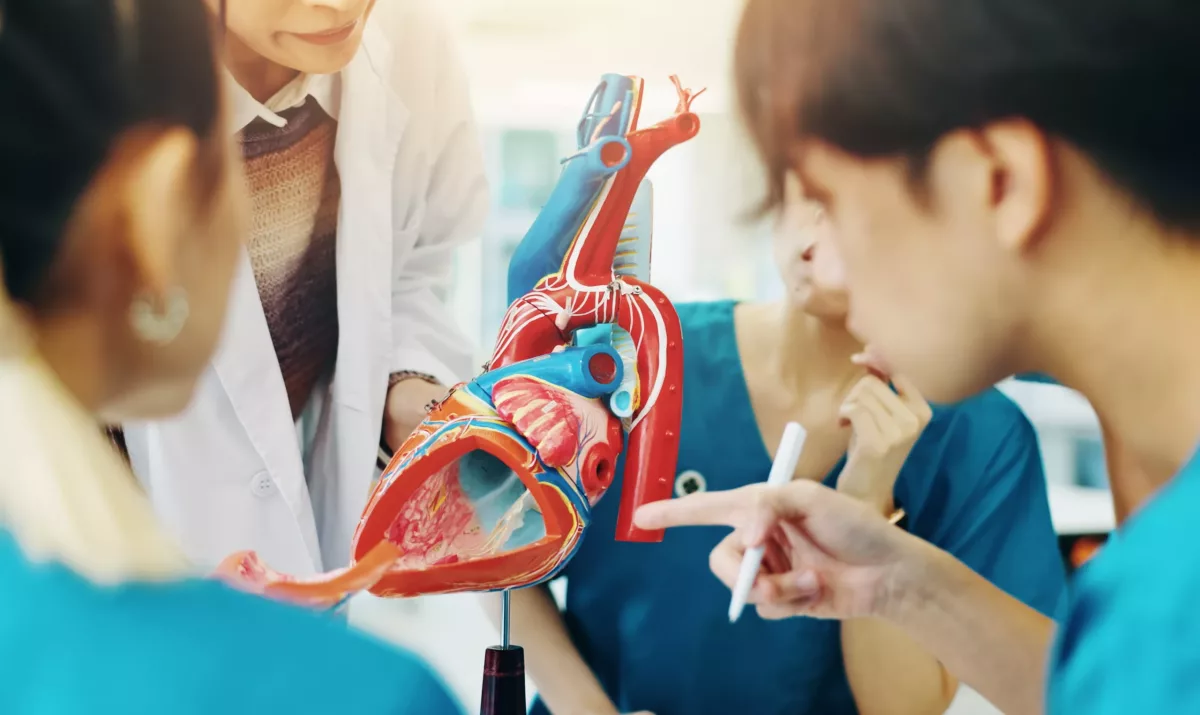The weakened part of the body’s main artery (called the aorta) in the chest is called a thoracic aortic aneurysm. The weak part of the aorta usually becomes wider. If it becomes very wide, an aneurysm occurs. Furthermore, aneurysms may occur anywhere in the thoracic aorta (such as near the heart).
This condition is also known as a thoracic aneurysm. When an aneurysm happens between the upper and lower parts of the aorta, the disease is called a thoracoabdominal aneurysm.
Usually, treatment for people with a thoracic aortic aneurysm is different because it depends on some factors. These include the cause, size, and exact location of the aneurysm, existing health problems, your age, and others. However, doctors often recommend regular checkups, medicines, and emergency surgery. Physicians may recommend emergency surgery when this type of aneurysm ruptures and makes a tear (also known as a dissection). Without treatment, dissections may lead to death.
Symptoms
Mostly, thoracic aortic aneurysms grow slowly and, in mild cases, do not cause any symptoms. Moreover, there are many thoracic aortic aneurysms that begin small and remain small. When the aneurysm becomes large, it may cause the following symptoms. Examples include:
Check below some additional symptoms that may occur if an aneurysm ruptures and causes a tear (also called aortic dissection):
- Sudden severe pain in the upper back that may spread down the body
- Breathing problems
- Pain in the neck, jaw, arms, or chest
- Hypotension (low blood pressure)
- Loss of consciousness
- Difficulty swallowing
In some cases, aneurysms never rupture.
However, most people with this condition do not have symptoms until the aneurysm ruptures. Go to the nearest emergency room or call 911 in the U.S. if you experience sudden pain in the chest.
Causes
There are multiple causes of thoracic aortic aneurysms. For example:
- Atherosclerosis – This is a condition in which a buildup of fats, cholesterol, and other substances occurs. These deposits are also called plaques, and they can narrow or even block blood flow through affected arteries. Over time, arteries become weak. The risk of atherosclerosis is high in people with chronic hypertension and high cholesterol.
- Genetic disorders – Usually, young people experience thoracic aortic aneurysms due to certain genetic conditions (such as Marfan syndrome) that weaken the walls of the arteries. The risk of this condition also increases if you have Loeys-Dietz syndrome or vascular Ehlers-Danlos syndrome.
- Blood vessel inflammation – There are some conditions that cause swelling (inflammation) and irritation of the blood vessels (such as Takayasu arteritis, giant cell arteritis, and others). As a result, these disorders make you more likely to develop thoracic aortic aneurysms.
- Bicuspid aortic valve – In normal circumstances, the valve located between the lower chamber of the heart and the aorta has 3 flaps. In people with this condition, the valve has only 2 flaps. Therefore, it elevates the risk of developing a thoracic aortic aneurysm.
- Infections – It happens rarely, but if you do not treat an infection (such as salmonella, syphilis, and others), it may lead to thoracic aortic aneurysms.
- Traumatic injury – If you are injured in falls, car accidents, and other situations, you may develop a thoracic aortic aneurysm. However, it happens quite rarely.
Risk Factors
Healthcare professionals have identified some factors that may increase your risk of developing a thoracic aortic aneurysm. Generally, anything that weakens or damages blood vessels elevates the risk of this condition. Check below some risk factors:
- Age – This condition is common among older adults (people over 65 years old).
- Smoking – People who smoke cigarettes or chew tobacco are at increased risk of developing this condition. Moreover, if you already have an aneurysm, smoking may worsen it.
- Hypertension (high blood pressure) – This condition may cause damage to the artery walls and cause a thoracic aortic aneurysm.
- Coronary artery disease – This is a heart disease that reduces blood flow to the heart. Thus, it may cause atherosclerosis, which damages the lining of blood vessels. It often occurs in older people.
- Family history of aortic aneurysms – If you have a parent or sibling with this condition, your risk of developing it significantly increases.
Usually, doctors recommend some medications that reduce the risk of this condition. For example, antihypertensives, medicines to relieve stress, and weakened arteries.
What Are The Potential Complications of Thoracic Aortic Aneurysm?
Those who suffer from a thoracic aortic aneurysm may also experience some complications, especially without treatment. Check some examples below:
- Aortic rupture (rupture of the aorta) – Commonly, this complication occurs due to a tear in the aorta that causes bleeding outside it. In general, it is a life-threatening complication that requires emergency medical care.
- Aortic dissection (tears in the wall of the aorta) – It is also a life-threatening complication that causes bleeding into and along the aortic wall. Without immediate treatment, it may lead to death.
- Blood clots – In some cases, small blood clots may develop in the affected area. These blood clots are dangerous because they can block blood flow to the heart and cause life-threatening complications (such as heart failure).
- Stroke – The most common symptoms of this complication include slurred speech, weakness, and inability to move.
How to Prevent Thoracic Aortic Aneurysm?
The only way to prevent this condition, you keep blood vessels as healthy as possible. Check below some tips:
- Quit smoking (if you have problems with smoking cessation, do not hesitate to discuss it with your doctor)
- Regularly exercise to maintain a healthy weight
- Manage chronic health conditions (such as high cholesterol, diabetes, hypertension, and others)
- Dietary changes (eating more nutritious foods)
In addition, doctors often recommend regular imaging tests (usually an echocardiogram) to look for an aneurysm in people who have a family history of aortic aneurysms or genetic disorders (such as Marfan syndrome).
Diagnosis
Usually, it is difficult to diagnose this condition because most of the time it does not cause any symptoms. In most cases, a thoracic aortic aneurysm is detected during an imaging test done for other reasons. Doctors may also ask some questions about your medical and family history because some aneurysms run in families. Check below some tests often used to diagnose a thoracic aortic aneurysm:
- Echocardiogram – Most thoracic aortic aneurysms are detected with this test. It uses sound waves that help doctors see how the blood moves through the heart and nearby blood vessels (including the aorta). If a regular test does not give enough details, you may choose a transesophageal echocardiogram, which helps see the aorta from inside the body.
- CT (computerized tomography) scans – This test produces cross-sectional images of the body (including the aorta). It helps see the size and shape of the aneurysm.
- Cardiac MRI (also called heart magnetic resonance imaging) scans – This is another imaging test that uses a magnetic field and radio waves to make detailed images of the heart and nearby blood vessels. It helps confirm the condition and rule out others that cause similar symptoms.
Treatment
The treatment goal is to stop the aneurysm from growing and prevent serious complications (such as aortic rupture). Usually, doctors recommend regular checkups (in mild cases), medicines, and surgery.
Screening
If an aneurysm is small and does not cause symptoms, doctors recommend regular checkups to see whether it grows. Usually, doctors perform imaging tests, including an echocardiogram, CT, or MRA (magnetic resonance angiography).
Medicines
The following medications are used to treat hypertension, high cholesterol, and other conditions that may cause aneurysms. Check below some examples:
- Beta-blockers – This group of medicines is used to reduce heart rate and hypertension. It also helps widen blood vessels in people with Marfan syndrome.
- Angiotensin 2 receptor blockers (also known as ARBs) – The following medications are often recommended when beta-blockers are not an option. Usually, doctors prescribe Losartan, Valsartan, and Olmesartan.
- Statins – These medications are used to reduce cholesterol and reduce the risk of blockages in the arteries. Doctors may prescribe Atorvastatin, Lovastatin, Simvastatin, and others.
Surgery and Other Treatments
Usually, the following treatments are recommended for people with an aortic aneurysm about 1.9 to 2.4 inches (approximately 5 to 6 centimeters) and larger. Surgery can be helpful for people with health conditions linked to thoracic aortic aneurysms (such as Marfan syndrome). Check below some procedures used to treat this condition:
- Open surgery – In most cases, people with thoracic aortic aneurysms have this major surgery. During this procedure, surgeons will remove the affected part of the aorta and replace it with a tube (known as a graft).
- Aortic root surgery – This treatment is used to prevent the aortic aneurysm from rupturing. It involves the removal of the affected part of the aorta and aortic valve (sometimes). Thereafter, they use a graft to replace the damaged part of the aorta.
- Endovascular aortic aneurysm repair (EVAR) – This is a less invasive surgery compared to open surgery. It uses small surgical cuts (incisions) that help recover faster. However, EVAR is not an option for everyone who suffers from thoracic aortic aneurysms.
- Emergency surgery – This treatment is needed when an aortic aneurysm ruptures. In addition, emergency surgery carries multiple risks of serious complications. That’s why it is important to detect and treat an aortic aneurysm before it ruptures.
Frequently Asked Questions
What is the survival rate for thoracic aortic aneurysm surgery?
In general, the survival rate is high in people with this condition, especially if surgery is performed before an aortic aneurysm ruptures or dissects. While survival rates are approximately 95% to 98% with regular surgeries, for those who need emergency surgery, the survival rates decrease to 37%.
What foods should you avoid if you have an aortic aneurysm?
There are some foods, drinks, and medicines that should be avoided by people with aortic aneurysms. For example, high-sodium, high-fat, high-cholesterol, and processed foods. They also should avoid refined carbohydrates and sugary drinks. Additionally, there are some antibiotics (such as Fluoroquinolones) that may increase the risk of an aortic aneurysm rupture.
Are there warning signs days before an aortic aneurysm?
Usually, people experience some sudden and severe symptoms when they develop an aortic aneurysm. These include throbbing and deep back or side pain, pulsating sensations near the belly button, shortness of breath, and fainting. Seek emergency medical care if any of the previous symptoms occur. Ask your healthcare provider if you have additional questions.




